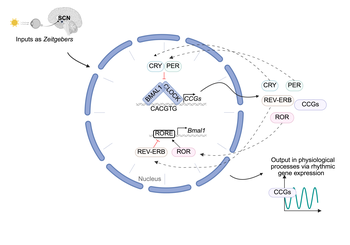
Tânia Cunha Alves , Kamil Musílek , Barbara Monti*
The circadian clock, as a molecular timekeeper, influences most behavioural and physiological processes. Numerous symptoms associated with neurodegenerative diseases, such as sleep disorders, anxiety, and mood alteration, are linked to circadian clock dysregulation. Dysregulation of the circadian system is increasingly implicated in the onset and progression of Alzheimer's disease, and emerging evidence highlights a bidirectional relationship between Alzheimer’s disease and circadian clock disruption. A crucial point is that the circadian clock regulates adult neurogenesis, a process that is significantly impaired in Alzheimer’s disease. Recent advancements suggest that the dynamic epigenetic mechanisms—including DNA and histone modifications as well as regulation by non-coding RNA—act as a critical regulation for circadian rhythms and neurogenesis. Therefore, research on circadian disruption and, particularly, focus on harmonising the circadian clock with neurogenesis in neurodegenerative diseases may also speed up the creation of innovative, circadian-based treatments to counteract the progress of neurological disorders from a new perspective. In this review, we explore potential epigenetic mechanisms linking the circadian system to neurodegenerative diseases, with a focus on Alzheimer’s Disease.
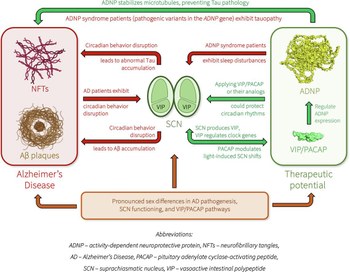
Artur Galushkin, Illana Gozes*
Current Research in Biotechnology 8 (2024) 100254
Alzheimer’s Disease (AD) represents a significant neurodegenerative challenge with current therapeutic strategies primarily focused on symptomatic management. This review explores the relationship between disrupted circadian rhythms, AD and the critical involvement of vasoactive intestinal peptide (VIP) and adenylate cyclase-activating polypeptide (PACAP) signaling pathways. These pathways hold promise for new drug development and provide insights into the complex pathogenesis of AD. Enhancement of brain bioavailability through advanced drug delivery systems is proposed and reviewed.
Mrutyunjaya Panda , Maria Markaki , Nektarios Tavernarakis*
Mitochondria are essential organelles that play crucial roles in various metabolic and signalling pathways. Proper neuronal function is highly dependent on the health of these organelles. Of note, the intricate structure of neurons poses a critical challenge for the transport and distribution of mitochondria to specific energy-intensive domains, such as synapses and dendritic appendages. When faced with chronic metabolic challenges and bioenergetic deficits, neurons undergo degeneration. Unsurprisingly, disruption of mitostasis, the process of maintaining cellular mitochondrial content and function within physiological limits, has been implicated in the pathogenesis of several age-associated neurodegenerative disorders. Indeed, compromised integrity and metabolic activity of mitochondria is a principal hallmark of neurodegeneration. In this review, we survey recent findings elucidating the role of impaired mitochondrial homeostasis and metabolism in the onset and progression of age-related neurodegenerative disorders. We also discuss the importance of neuronal mitostasis, with an emphasis on the major mitochondrial homeostatic and metabolic pathways that contribute to the proper functioning of neurons. A comprehensive delineation of these pathways is crucial for the development of early diagnostic and intervention approaches against neurodegeneration.
Alexandra Lobyntseva , Maram Ganaiem , Yanina Ivashko-Pachima , Colin J Barnstable , Batsheva Weisinger , Ana Parabucki , Yaron Segal , Esther Shohami , Illana Gozes*
Eur J Neurosci. 2025 Feb;61(4):e70023.
Aberrant microtubule dynamics coupled with a reduction in Tau-microtubule interaction are at the core of neuronal injuries resulting in microtubule disruption and aggregates of abnormally phosphorylated Tau. These pathological Tau aggregates define tauopathies such as Alzheimer's disease (AD), as well as the pathological sequelae following traumatic brain injury (TBI), stroke and spinal cord injury (SCI). We hypothesized that differential applications of extremely low-frequency and low-intensity electromagnetic field (ELF-EMF) will change microtubule function. To examine our hypothesis, we pre-applied ELF-EMF to a neuroblastoma neuronal cell line later exposed to 4 h of zinc intoxication, modelling Tau-microtubule dissociation. ELF-EMF (40 Hz and 1 G; multiple exposure schedules) enhanced microtubule dynamics and increased Tau-microtubule interaction in the face of zinc toxicity. Complementing these preconditioning neuroprotective effects, concomitant 1 h treatment protocols comparing 3.9 or 40 Hz and 1 G exposure, indicated effects on Tau phosphorylation accentuated with 40 Hz and reduction in beta tubulin isotypes, depending on electromagnetic frequencies, most pronounced at 3.9 Hz. Our results discovered ELF-EMF modulation on the microtubule cytoskeleton essential for brain health.
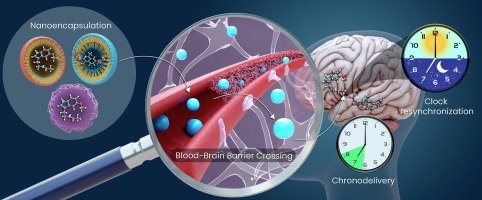
Marion Le Meur, Jaime Pignatelli, Paolo Blasi*, Valle Palomo*
Adv Drug Deliv Rev. 2025 May:220:115561
Circadian rhythms and their involvement with various human diseases, including neurological disorders, have become an intense area of research for the development of new pharmacological treatments. The location of the circadian clock machinery in the central nervous system makes it challenging to reach molecular targets at therapeutic concentrations. In addition, a timely administration of the therapeutic agents is necessary to efficiently modulate the circadian clock. Thus, the use of nanoparticles in circadian clock dysfunctions may accelerate their clinical translation by addressing these two key challenges: enhancing brain penetration and/or enabling their formulation in chronodelivery systems. This review describes the implications of the circadian clock in neurological pathologies, reviews potential molecular targets and their modulators and suggests how the use of nanoparticle-based formulations could improve their clinical success. Finally, the potential integration of nanoparticles into chronopharmaceutical drug delivery systems will be described.
Charline Monnier , Rudolf Andrys* , Irene Castellino , Veronika Mickova , Annamaria Haleckova , Jan Loskot , Ondrej Benek , Lucie Zemanova.
Animal liver microsomes are a rich source of carboxylesterases with potential for biocatalytic applications. However, their instability and difficulty in reuse limit their practical application. This study investigates the immobilization of animal liver microsomes from four species Mus musculus (house mouse), Sus scrofa (wild boar), Dama dama (fallow deer), and Capreolus capreolus (roe deer) on Perloza MG microparticles for enhanced stability and reusability. Immobilization significantly improved the stability and pH tolerance of the microsomes, particularly those from D. dama, maintaining esterase activity across a broad pH range (5-9) and enabling the reusability over ten consecutive cycles. The immobilized D. dama microsomes were successfully employed in a preparative-scale chemo-enzymatic synthesis of a cyclophilin D inhibitor, achieving a total reaction yield of 68% with 98% final product purity, demonstrating their potential for sustainable organic synthesis.
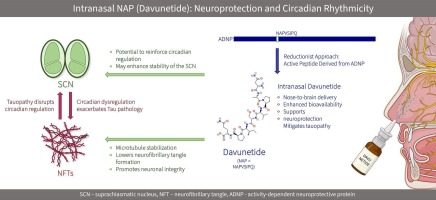
Artur Galushkin, Illana Gozes*
Advanced Drug Delivery Reviews, Volume 220, May 2025, 115573
In this review we examine the neuroprotective potential of NAP (davunetide), a small peptide derived from Activity-Dependent Neuroprotective Protein (ADNP), in the context of neurodevelopmental and neurodegenerative disorders. ADNP, a protein essential for brain development and function, is associated with tauopathy-related diseases, such as Alzheimer’s Disease (AD), and circadian rhythm regulation. NAP enhances microtubule stability and prevents tauopathy. In preclinical studies, NAP shows promise in improving cognitive performance and correcting behavioral deficits in different models. Clinical studies on NAP (davunetide) administered via intranasal delivery have demonstrated its safety, favorable bioavailability, and potential efficacy in improving cognitive function, making it a viable therapeutic option. In the pure tauopathy, progressive supranuclear palsy, NAP (davunetide) significantly slowed disease progression in women in a phase II-III clinical trial. Additionally, the complex interactions between ADNP, associated pathways, and circadian regulation and the extensive NAP compensation upon ADNP deficiency attest to further clinical development. Thus, NAP is an example of a reductionist approach in drug delivery, replacing/enhancing the critical large ADNP-related pathways including dysregulated microtubules and tauopathy with a small brain bioavailable investigational drug, davunetide.
Silvia Mori , Damiano Arella , Michael Decker*
Trends Pharmacol Sci. 2025 Jul 1:S0165-6147(25)00099-9
G protein-coupled receptors (GPCRs) regulate numerous pathophysiological processes and have traditionally been modulated at the orthosteric site. Targeting allosteric sites offers an alternative approach that can enhance selectivity, modulate signal bias, and reduce side effects. Photopharmacology enables precise spatial and temporal drug control of receptors by light using modified drug molecules incorporating chemical photoswitches, especially azobenzenes. Allosteric and dualsteric photoswitchable ligands, the latter targeting both orthosteric and allosteric sites, are being developed - to date mainly at metabotropic glutamate (mGlu), muscarinic acetylcholine (mACh or M), and cannabinoid (CB) receptors, since their allosteric sites have been described in the most detail and with the largest number of respective allosteric ligands developed. The novel ligands can photocontrol even more refined GPCR functions, like signal bias and degrees of partial agonism. This review describes the recent development for these GPCRs in allosteric and dualsteric photoswitchable ligands, highlighting the specific challenging design, which is even more complex than for orthosteric photoswitchable ligands, since structure-activity relationships (SARs) are steep and often insufficiently described, and spacer structures strongly influence binding.
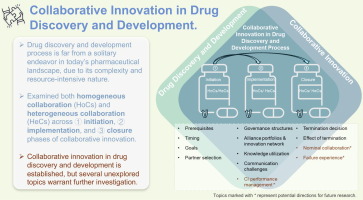
Xue Wu* , Mirjam Knockaert , Paolo Blasi *
Drug Discov Today. 2025 Jul;30(7):104409
Given the complexity and resource-intensive nature of the drug discovery and development process, breakthrough innovations often stem from multidisciplinary collaborations. This systematic literature review examines collaborative innovation within this process, analyzing current practices and identifying future research directions. The review used an evidence-based approach, retrieving 737 papers through a Web of Science "All Databases" search, and ultimately selecting 74 articles for discussion. The articles were categorized according to the initiation, implementation, and closure phases of collaborative innovation, and were classified into homogeneous and heterogeneous collaborations. Using this framework, we systematically reviewed the existing knowledge, with a particular focus on how collaborative innovation can be successfully initiated and implemented, and how it can generate positive outcomes for drug research.
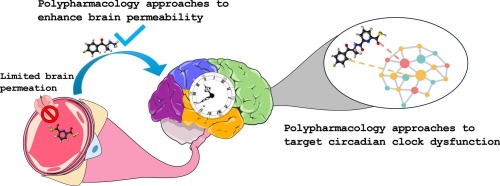
Dionysis Kampasis, Elisa Uliassi*, Maria Laura Bolognesi*
Advanced Drug Delivery Reviews, Volume 223, August 2025, 115621
Circadian rhythm disruption (CRD) is a common feature of several brain disorders. The restoration of circadian clock function and the development of circadian-based therapies may have significant therapeutic implications for brain diseases that extend beyond sleep disorders. However, several challenges persist due to the complexity of circadian interactions with multiple cellular pathways underlying CRD in brain diseases, together with the CNS compartmentalization, including the presence of the blood–brain barrier (BBB). Against these drawbacks, polypharmacology is a promising strategy to potentially provide greater efficacy by targeting multiple components of the CRD network through drug combinations or multi-target-directed ligands. Polypharmacology also offers innovative approaches to brain drug delivery by enhancing BBB penetration of CNS-directed drugs using combinations, co-drugs, and targeted prodrugs. Herein, we review polypharmacological strategies to improve BBB permeability of CNS agents and suggest the exploitation of polypharmacology as a promising new avenue for circadian clock modulation in the treatment of brain disorders.
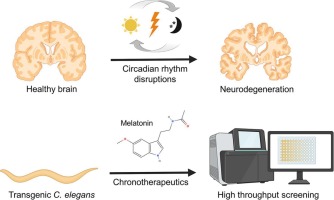
Mrutyunjaya Panda , Maria Fakitsa , Maria Markaki , Nektarios Tavernarakis*
Advanced Drug Delivery Reviews Volume 224, September 2025, 115655
An increase in the aging population is accompanied by increased susceptibility to age-associated neurodegeneration, with currently no cure. Despite the diversity of symptoms and etiologies, neurodegenerative disorders share mechanistic commonalities and many pathophysiological features. These include disruptions in circadian rhythms that affect neuronal physiology. Systematic investigations in several animal models have advanced our understanding of the molecular processes that link circadian rhythms and neurodegenerative disease states. These models have also been used to screen and validate promising chronotherapeutic drug candidates that target the circadian clock to ameliorate neurodegeneration. With the emergence of robust and reliable methodologies to measure daily rhythms, the nematode model Caenorhabditis elegans has become a versatile tool for high throughput chronotherapeutic drug screening against neurodegenerative disorders. In this review, we discuss the unique features and advantages of C. elegans as an enabling platform for chronotherapeutic drug discovery, towards the development of innovative strategies for the treatment of human neurodegenerative conditions.